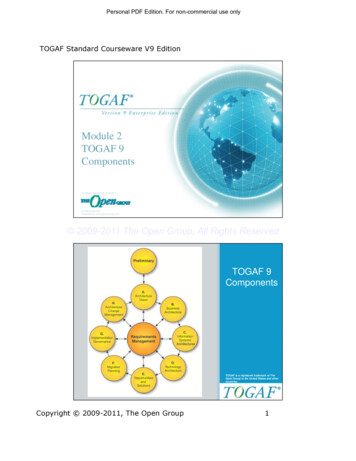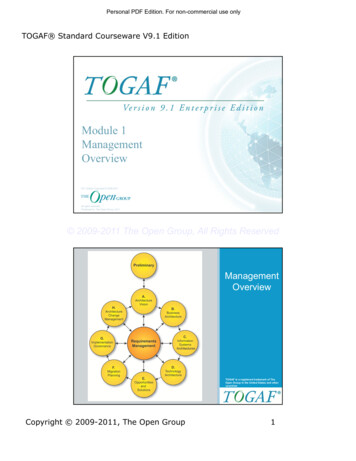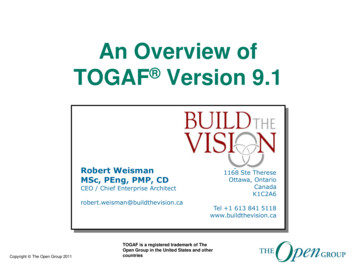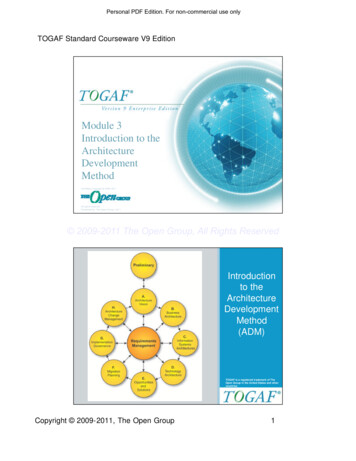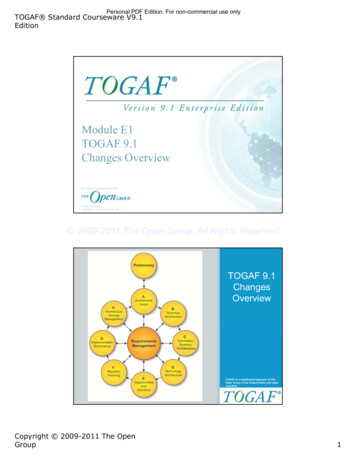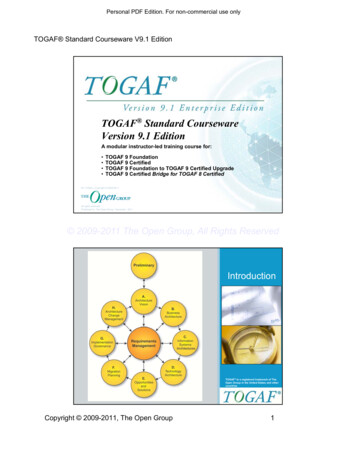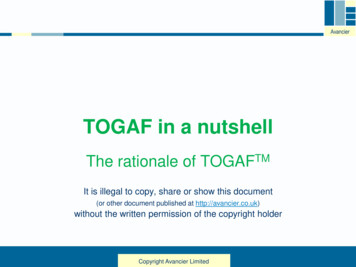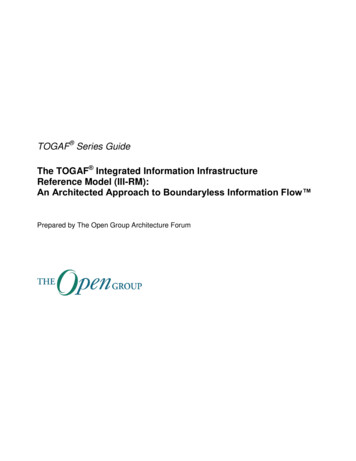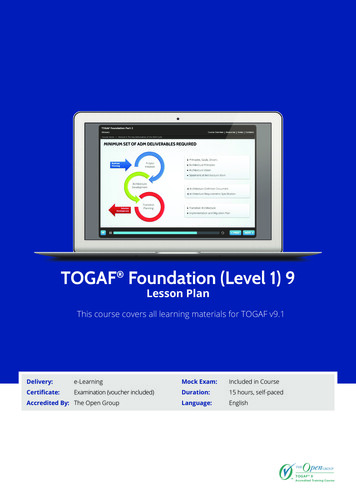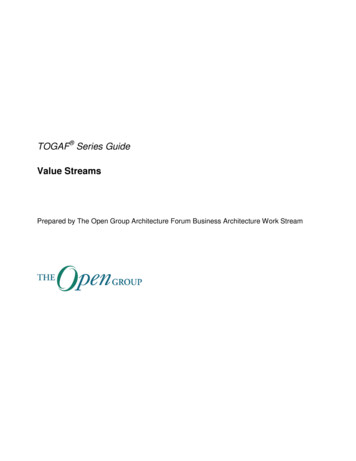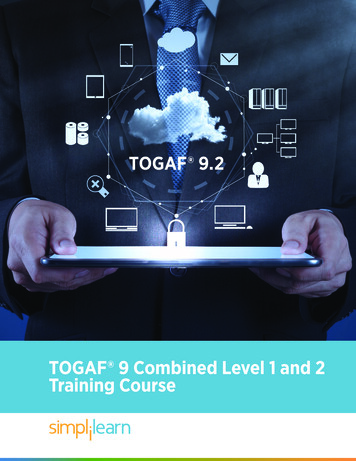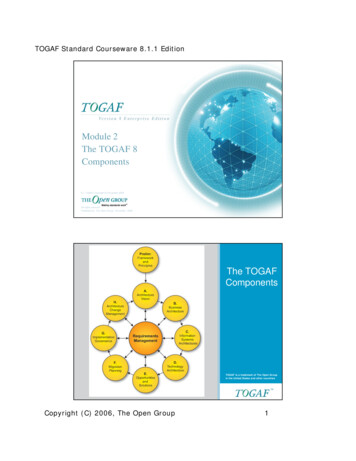
Transcription
TOGAF Standard Courseware 8.1.1 EditionModule 2The TOGAF 8Components8.1.1 Edition Copyright November 2006TMSlide 1 of 18All rights reservedPublished by The Open Group, November 2006TOGAF ComponentsThe TOGAFComponentsTOGAF is a trademark of The Open Groupin the United States and other countriesTMSlide 2 of 18Copyright (C) 2006, The Open GroupTM1
TOGAF Standard Courseware 8.1.1 EditionModule Objectives To highlight and understand the main components ofTOGAF To understand their relationship to each other Further details on each component will be provided in latermodulesTMSlide 3 of 18TOGAF 8 ComponentsEnterprise ContinuumADMArchitecture PrinciplesBusiness ScenariosRequest for Architecture WorkStatement of Architecture WorkArchitecture Documents (BA,DA,TA)Architecture BoardArchitecture ComplianceArchitecture ContractArchitecture Skills FrameworkResource BaseArchitecture ViewsArchitecture GovernanceBuilding BlocksArchitecture PrinciplesBusiness ScenariosArchitecture Maturity ModelsArchitecture PatternsTMSlide 4 of 18Copyright (C) 2006, The Open Group2
TOGAF Standard Courseware 8.1.1 EditionArchitectureDevelopment Method The core of TOGAF A proven way of developingan architecture Specifically designed toaddress businessrequirements An iterative method A set of architecture views toensure that a complex set ofrequirements are adequatelyaddressedTMSlide 5 of 18The Enterprise Continuum A virtual repository of all architecture assets––––Models, patterns, architecture descriptionsDeliverables produced in this iteration of the ADMDeliverables produced in other iterations of the ADMAssets from the industry at large TOGAF provides two reference models for possibleinclusion in an organization’s Enterprise Continuum– The TOGAF Foundation Architecture– The Integrated Information Infrastructure Reference ModelTMSlide 6 of 18Copyright (C) 2006, The Open Group3
TOGAF Standard Courseware 8.1.1 EditionThe TOGAF Foundation Architecture An architecture of generic services and functions It provides a foundation on which architectures andarchitecture building blocks can be built It consists of two pieces– The TOGAF Technical Reference Model (TRM) A model and a taxonomy of generic platform services– The TOGAF Standards Information Base (SIB) A database of open industry standards that can be used to defineservices and components for an enterprise architectureTMSlide 7 of 18High-Level TRMTMSlide 8 of 18Copyright (C) 2006, The Open Group4
TOGAF Standard Courseware 8.1.1 EditionDetailed TRMTMSlide 9 of 18The Standards Information BaseTMSlide 10 of 18Copyright (C) 2006, The Open Group5
TOGAF Standard Courseware 8.1.1 EditionThe Integrated Information InfrastructureReference Model (III-RM) An example of a Common Systems Architecture– So a lower level abstraction than the TRM Based on the TRM Aimed at the helping the design of architectures to enableand support the vision of Boundaryless Information FlowTMSlide 11 of 18The Integrated Information InfrastructureReference Model (III-RM)TMSlide 12 of 18Copyright (C) 2006, The Open Group6
TOGAF Standard Courseware 8.1.1 EditionThe TOGAF Resource Base A set of resources, guidelines, templates, backgroundinformation etc For reference during application of the ADM Covers a broad range of topics used to develop anarchitectureTMSlide 13 of 18The TOGAF Resource Base Architecture BoardArchitecture ComplianceArchitecture ContractsArchitecture GovernanceArchitecture Maturity ModelsArchitecture PatternsArchitecture PrinciplesArchitecture Skills FrameworkDeveloping Architecture ViewsBuilding Blocks Business Process Domain ViewsBusiness ScenariosCase StudiesGlossaryOther Architectures andFrameworks Tools for ArchitectureDevelopment ADM and the ZachmannFrameworkTMSlide 14 of 18Copyright (C) 2006, The Open Group7
TOGAF Standard Courseware 8.1.1 EditionPutting it AltogetherTMSlide 15 of 18Summary Architecture Development Method (ADM)– An iterative sequence of steps to develop an enterprise-widearchitecture The Enterprise Continuum– A virtual repository of architecture assets. During application of theADM, assets are created or drawn from existing assets, used,modified and returned to the virtual repository Resource Base– During application of the ADM, processes, templates, checklists andother items from the Resource Base are deployed as methods todevelop the architectureTMSlide 16 of 18Copyright (C) 2006, The Open Group8
TOGAF Standard Courseware 8.1.1 EditionTest Yourself QuestionQ: Which of the following is not considered one of the threemain parts of TOGAF?A. The Architecture Development MethodB. The Enterprise ContinuumC. The Technical Reference ModelD. The TOGAF Resource BaseTMSlide 17 of 18TOGAF ComponentsThe TOGAFComponentsTOGAF is a trademark of The Open Groupin the United States and other countriesTMSlide 18 of 18Copyright (C) 2006, The Open GroupTM9
– Models, patterns, architecture descriptions – Deliverables produced in this iteration of the ADM – Deliverables produced in other iterations of the ADM – Assets from the industry at large TOGAF provides two reference models for possible inclusion in an organization’s Enterprise Conti
